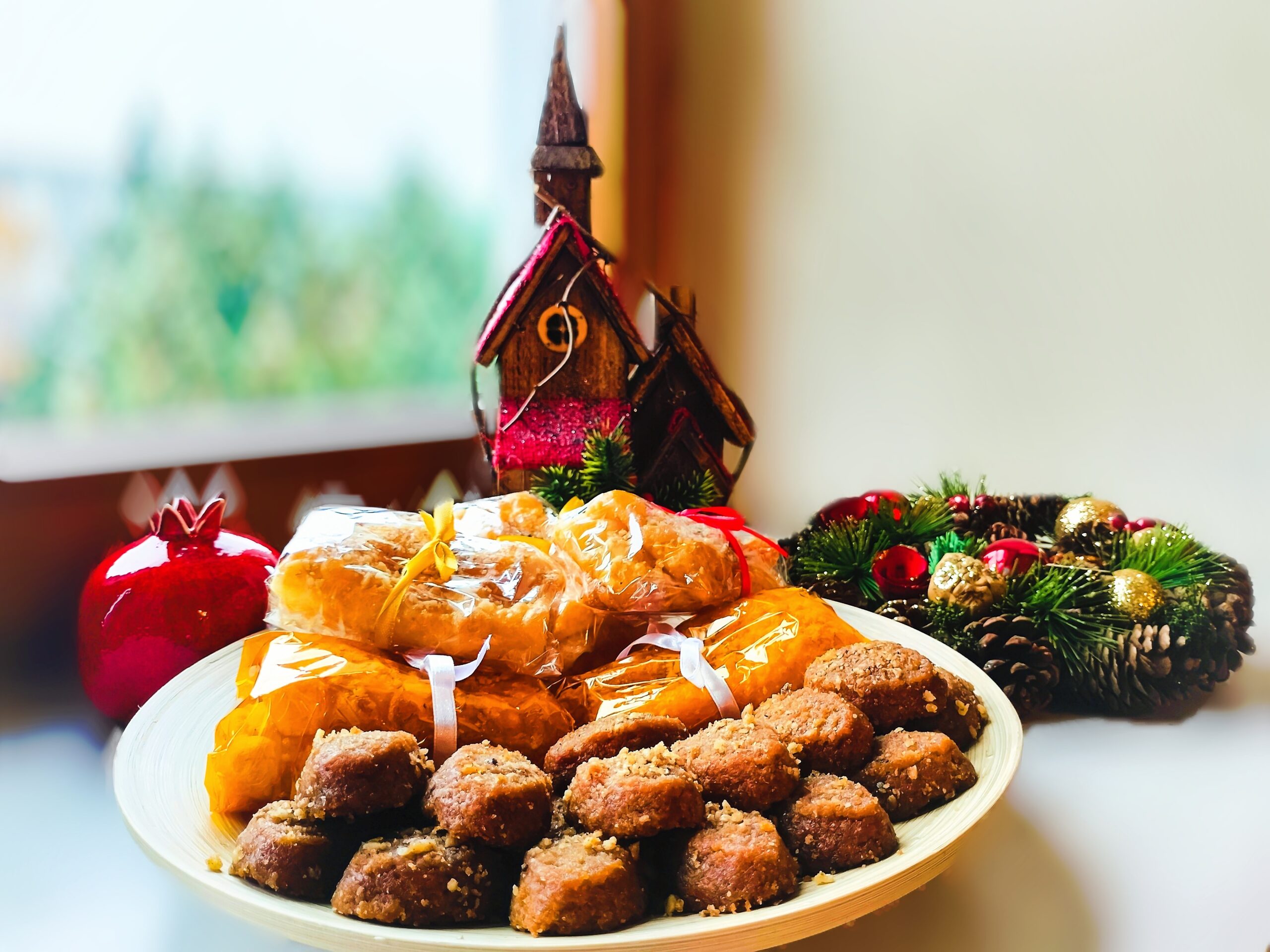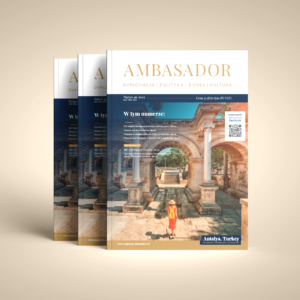Prepared by H.E. Niki Kamba, Ambassador of the Hellenic Republic
Greek cuisine represents more than 4,000 years of culinary tradition, combining the triad of Sun, Water and Earth, and is aromatic, colourful and healthy. It uses a wide range of noble and pure products and offers vibrant flavours and nutritional value. The most popular ingredients in traditional Greek dishes are olive oil and olives (Kalamon, Koroneiki, etc.), fresh herbs (oregano, rosemary, thyme, etc.), a huge variety of honeys (pine, thyme, orange, thistle, chestnut, etc.), cheeses (feta, manouri, graviera, kefalotyri, etc.), as well as various types of fish and meat.
In Greece, we are fortunate to have a favourable climate, and thanks to the abundance of fruits and vegetables, we can enjoy light and healthy food alternatives. By choosing citrus “horta” (greens: Amaranthus blitum, cichorium, endive, etc.), dried legumes (chickpeas, lentils), fresh vegetables, fish and seafood, it is optimal to increase and enrich healthy choices and follow the Mediterranean diet. And for preparing and “dressing” Greek plates, of all these products, the most essential elements in any Greek household are olive oil, lemon and onions.
Greek dishes reflect the seasons and follow the holiday calendar, harmoniously balancing flavour and tradition. In addition to the celebration of fresh ingredients, there is also the joy of gathering around the table with loved ones. The festive atmosphere and joy of family gatherings are highlighted by the variety of carefully selected products served on special occasions.
CHICKEN SOUP WITH DELICIOUS EGG AND LEMON SAUCE – “AVGOLEMONO”
Chicken soup with egg and lemon sauce is undoubtedly the perfect dish for a cold winter day. The secret ingredient of this warming soup is the delicious “avgolemono” (egg and lemon sauce).
30′ preparation
1 hour 30′ cooking time
Serves 6
INGREDIENTS
1 medium chicken
2 large, dried onions, peeled (one whole and one chopped)
2 large carrots, peeled (one whole and one chopped)
2 bay leaves
3/4 cup of rice for soup
60 ml of olive oil
salt, freshly ground pepper
Lemon egg sauce
2 eggs
juice of 1–2 lemons
PREPARATION
Warm chicken broth
- Season the chicken with salt and pepper and place in a deep pot with 1.5 litres of water. Then place over medium heat and cook for about 10 minutes, skimming if necessary.
- Add all the onion, bay leaves and all the carrot, reduce the heat and simmer covered for about 1 hour until the chicken is tender. Using a straining spoon and fork, transfer the chicken to a platter.
- Drain the broth and set aside in a bowl. Drain the chicken and chop finely.
- Heat oil over medium heat and sauté the chopped, cooked vegetables for 2–3 minutes.
- Add broth, salt and pepper and cook for 10 minutes until vegetables are tender.
- Add rice and cook, keeping covered until ready.
- Add the chicken pieces and turn off the heat, leaving the pot on the hot stove.
Egg and lemon sauce
In a bowl, whisk the eggs (they should be at room temperature) until frothy.
Without stopping whisking, add the lemon juice and gradually add 1/3 of the broth from the pot until the egg lemonade is heated through.
Pour into the pot and stir to combine the ingredients.
Tips:
* eggs should be at room temperature.
* the soup should be warm, but not boiling.
* the egg mixture should be the same temperature as the broth.
PORK WITH QUINCE
The classic Christmas dish “kydonato” is made in various regions of the country, from Pelion to Macedonia and from the Peloponnese to the Dodecanese.
30′ preparation
3 hours 15′ cooking time
Serves 6
INGREDIENTS
1½ kg of pork neck, cut into 6 large pieces
2 large onions in large slices
2 tablespoons of tomato paste
1 teaspoon cinnamon + 1 teaspoon allspice powder
4–5 cloves
1 tbsp harissa or 1 teaspoon hot chilli peppers
300 ml of sweet red wine (Mavrodaphne)
300 ml of vegetable or poultry broth
6 quinces, peeled and cut into 4 or 8 pieces (depending on size)
50 ml of olive oil
salt, freshly ground pepper
PREPARATION
- To prepare the quince pork, first preheat the oven to 180°C.
- In a saucepan, heat the oil over medium heat and fry the meat for 7–8 minutes, until it is well browned on all sides. Transfer the meat to a plate and add the onions, paste, cinnamon, allspice, cloves, harissa or hot chilli peppers and salt and pepper to the saucepan. Fry for 3–4 minutes, until the onions become translucent and the spices release their aroma.
- Put the meat back in, pour in the wine and after 2 minutes add the broth. Season with salt and pepper and remove.
- Transfer all ingredients to the pot, cover with a lid and cook for about 1 hour and 15 minutes, until the meat is semi-soft.
- Remove from the oven, carefully open the lid, arrange the quinces between the pieces of meat and continue cooking for about 1 hour and 15 minutes until the dish is tender.
It is recommended to serve the pork with quince along with the juices. If necessary, you can cut the meat into smaller pieces.
MELOMAKARONA – Christmas honey cookies
30′ preparation
1 hour 20′ cooking time
INGREDIENTS
For the syrup
500 g water
800 g granulated sugar
150 g honey
3 cinnamon sticks
3 whole cloves
1 orange, cut in half
- mixture
400 g of orange juice
400 g of seed oil
180 g olive oil
50 g sugar
1/2 teaspoon ground cloves
2–3 teaspoons of cinnamon
1/4 teaspoon nutmeg
1 teaspoon of baking soda
orange peel from 2 oranges
- mixture
1 kg of all-purpose flour
200 g semolina, fine
Serving
Walnuts for sprinkling
PREPARATION
- Boil all the ingredients for the syrup, except the honey, until you have a sugar paste. Remove from heat. Add honey and stir to combine.
- Set the syrup aside to cool for 3–4 hours. It must be cold before removing the cookies from the oven. The syrup can be prepared the day before.
- Preheat the oven to 370°F (190°C) set to fan.
- Prepare two separate mixtures for the cookies.
- For the first mixture, add all ingredients to a large bowl. Mix, using a hand whisk.
- In a separate bowl, add all the ingredients for the second mixture.
- Combine the first and second mixtures.
- Mix by hand, very gently and for a very short time (10 seconds max). Prolonged mixing will cause the mixture to delaminate or curdle.
- Form oval cookies from the dough, 3–4 cm long and weighing 30 g each. Try to make them as similar as possible.
- Bake for about 20–25 minutes until they are crisp and golden brown.
- Immediately after removing from the oven, dip the hot cookies into the syrup for 10 seconds.
- Drain them on a wire rack.
- Sprinkle with chopped walnuts.
Tips:
Be careful not to overwork the cookie dough, as the oil may start leaking out, in which case the cookies will not be crispy. The orange used for the syrup should be a whole fresh orange, cut in half.



Sledź nas na: